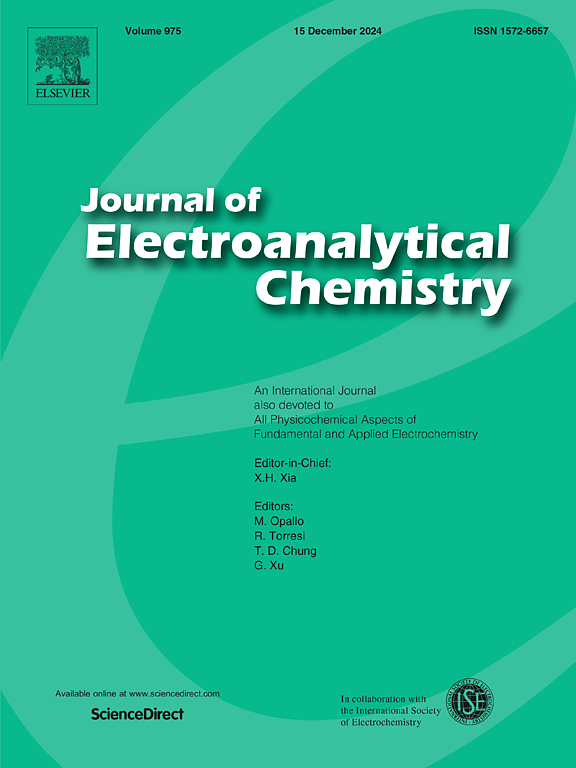为更可持续的燃料电池寻找生物醇:在金上的甘油平台分子的电化学氧化
IF 4.1
3区 化学
Q1 CHEMISTRY, ANALYTICAL
引用次数: 0
摘要
在这项工作中,研究了一种来自甘油的生物基平台分子(即甘油醇)在金电极上的电化学氧化,并与甘油的电氧化进行了比较,因为两者都是来自相同可再生生物质来源的c3基醇。通过循环伏安法、计时安培法和原位傅立叶变换红外光谱(FTIR)实验,在室温下分别在碱性和酸性介质中对反应机理和产物生成进行分析。甘油和甘油三酯在碱性条件下均表现出较高的反应活性。然而,甘油在金电极上的氧化表现出比甘油醇更高的活性,这可以归因于甘油醇高度稳定的循环结构和它们的醇基酸度的差异。FTIR分析和原位红外反射吸收光谱分析显示,甘二醇电氧化过程中形成了各种羧酸阴离子和碳酸盐,表明在某些情况下发生了CC键的完全断裂。这些发现为研究甘油衍生分子在金上的电化学行为提供了有价值的见解,有助于开发更可持续的生物基燃料。本文章由计算机程序翻译,如有差异,请以英文原文为准。
Searching bioalcohols for more sustainable fuel cells: On the electrochemical oxidation of a glycerol platform molecule on gold
In this work, the electrochemical oxidation of a bio-based platform molecule derived from glycerol, namely glycidol, was investigated on gold electrodes and compared to the electrooxidation of glycerol, since both are C3-based alcohols derived from the same renewable biomass source. Cyclic voltammetry, chronoamperometry, and in situ Fourier-transform infrared spectroscopy (FTIR) experiments were performed in alkaline and acidic media at room temperature to analyze reaction mechanisms and products formation. Both glycerol and glycidol exhibited high reactivity in alkaline conditions. Nevertheless, glycerol oxidation on gold electrodes showed higher activity than glycidol, which can be attributed to the highly stable cyclic structure of glycidol and differences in the acidity of their alcohol groups. FTIR analysis and in situ infrared reflection absorption spectroscopy of glycidol electrooxidation revealed the formation of various carboxylate anions and also carbonate, indicating that in some cases the complete cleavage of the C![]() C bond has taken place. These findings provide valuable insights into the electrochemical behavior of glycerol-derived molecules on gold, contributing to the development of more sustainable bio-based fuels.
C bond has taken place. These findings provide valuable insights into the electrochemical behavior of glycerol-derived molecules on gold, contributing to the development of more sustainable bio-based fuels.
求助全文
通过发布文献求助,成功后即可免费获取论文全文。
去求助
来源期刊
CiteScore
7.80
自引率
6.70%
发文量
912
审稿时长
2.4 months
期刊介绍:
The Journal of Electroanalytical Chemistry is the foremost international journal devoted to the interdisciplinary subject of electrochemistry in all its aspects, theoretical as well as applied.
Electrochemistry is a wide ranging area that is in a state of continuous evolution. Rather than compiling a long list of topics covered by the Journal, the editors would like to draw particular attention to the key issues of novelty, topicality and quality. Papers should present new and interesting electrochemical science in a way that is accessible to the reader. The presentation and discussion should be at a level that is consistent with the international status of the Journal. Reports describing the application of well-established techniques to problems that are essentially technical will not be accepted. Similarly, papers that report observations but fail to provide adequate interpretation will be rejected by the Editors. Papers dealing with technical electrochemistry should be submitted to other specialist journals unless the authors can show that their work provides substantially new insights into electrochemical processes.

 求助内容:
求助内容: 应助结果提醒方式:
应助结果提醒方式:


